

 Vol. 39 (Nº22) Year 2018. Page 40
Vol. 39 (Nº22) Year 2018. Page 40
Elena SMIRNOVA 1
Received: 02/02/2018 • Approved: 05/03/2018
ABSTRACT: The imagination of the contemporary masters of the arts who are engineering and designing the world influences the style of real architecture and construction being far ahead of its time and technological advances. The sphere of mind (nooshere) has started to determine an impact on the evolution of the Earth. The technosphere created artificially by a man has posed a real threat of destroying a natural equilibrium, wherefore the environmental problems have acquired global dimensions. There appeared a threat for environmental safety for everybody living on the Earth. In this regard the main purpose of the article is to show a control capability of environmental safety for the ‘green’ construction paradigm. The environmental safety is aimed at reaching the state, when the interaction of nature and a person takes place within the boundaries of the dynamically stable equilibrium. So the solicitous attitude to the treasures of nature, saving of labour and releasing time for creative work come forward as the basis of balanced scientific and technical progress in the developed and developing countries. Herefrom, a concept of the ‘developed’ country implies designing the ‘green medium’ safe and comfortable for habitation, which will prepare and ensure the coevolution of man and nature. The ‘Black Square’ by Malevich as one of the first demonstrations of threats related to uncontrolled, dangerous and economically costly progress of society became a symbol of necessity of environmental and technospheric safety. |
RESUMEN: La imaginación de los maestros contemporáneos de las artes que están ingeniando y diseñando el mundo influye en el estilo de la arquitectura y la construcción reales, muy por delante de su tiempo y avances tecnológicos. La esfera de la mente (nooshere) ha comenzado a determinar un impacto en la evolución de la Tierra. La tecnosfera creada artificialmente por un hombre ha planteado una amenaza real de destruir un equilibrio natural, por lo que los problemas ambientales han adquirido dimensiones globales. Apareció una amenaza para la seguridad del medio ambiente para todos los que viven en la Tierra. En este sentido, el objetivo principal del artículo es mostrar una capacidad de control de la seguridad ambiental para el paradigma de construcción ‘verde’. La seguridad ambiental tiene como objetivo alcanzar el estado, cuando la interacción de la naturaleza y la persona tiene lugar dentro de los límites del equilibrio dinámico estable. De este modo la actitud solícita hacia los tesoros de la naturaleza, el ahorro de mano de obra y el tiempo para el trabajo creativo presentarse como la base del progreso científico y técnico equilibrado en los países desarrollados y en desarrollo. De aquí, un concepto del país ‘desarrollado’ implica diseñar el ‘medio verde’ seguro y cómodo para la habitación, que preparará y asegurará la coevolución del hombre y la naturaleza. La ‘Plaza Negra’ de Malevich como una de las primeras demostraciones de amenazas relacionadas con el progreso descontrolado, peligroso y económicamente costoso de la sociedad se convirtió en un símbolo de la necesidad de la seguridad ambiental y tecnosférica. |
It was in 1914 that architect Antonio Sant'Elia displayed 16 architectural fantasies themed ‘New City – the City-Machine’ at an exhibition in Milan. His ‘dynamic’ drawings remind us of the fantastic etching series by Giovanni Piranesi. In the 1930s architect Jakob Tchernykhov in the USSR created a number of ‘melodies of constructivism’ called the ‘Architectural Fantasies’ that earned him the reputation of being ‘the Soviet Piranesi’. The list of examples of vertical tower-like structures and simple load-carrying constructions may be continued. However, in any of these images we cannot see any scaled figure.
Figure 1.1
The ‘Perspective drawing from La Città Nuova’ (1914), Antonio Sant'Elia (1888–1916)
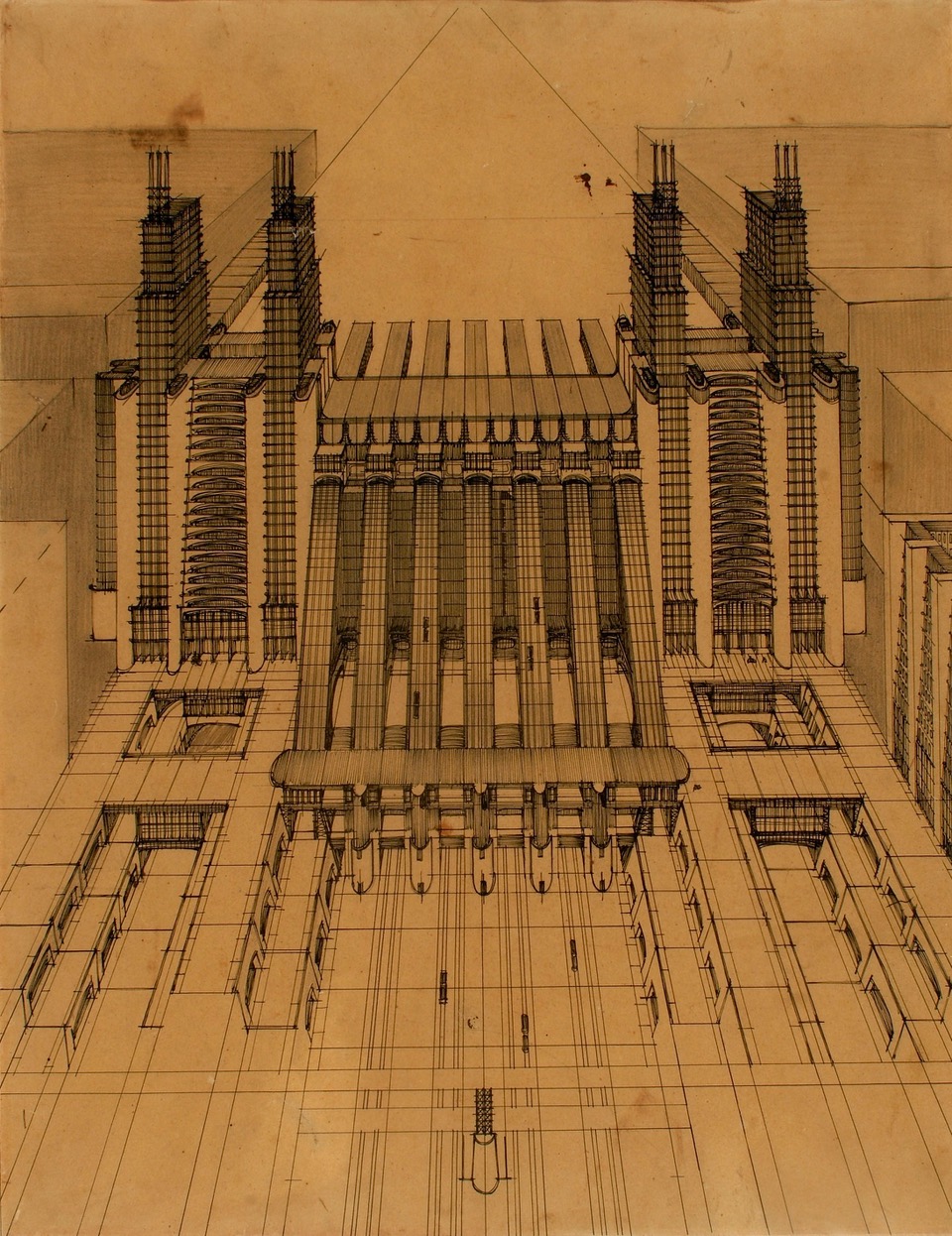
-----
Figure 1.2
The ‘Composition 18’ (Dynamics of vertical and horizontal. Demonstration of
aspiration and majesty. Composition of circular linear rings, curves and straight lines) (1929)
, Jakob Tchernykhov (1889-1951) (the speculative constructivism of his early architectural experiments, 1925–1932)
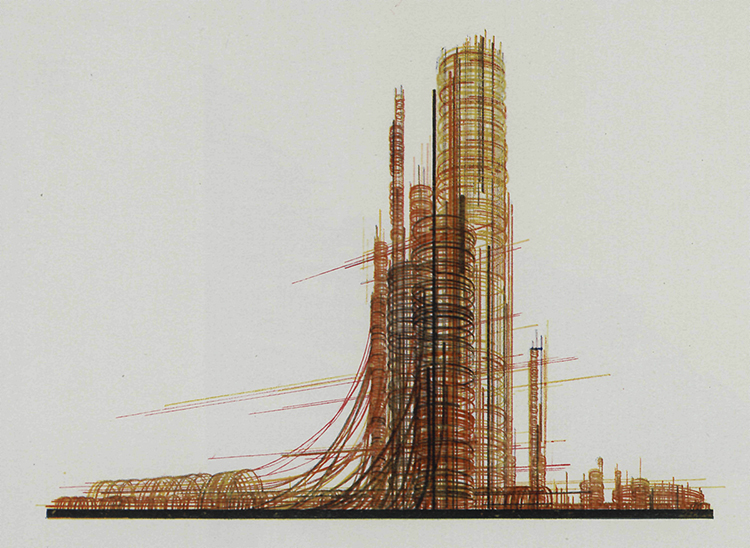
There is a clear explanation why. Projective constructive fantasy of modern masters of architecture does not simply provide an impulse for the real creativity; it influences the style of practical architecture, drawing main lines for transformation of the world around us, leaving the current time and technological development far behind. These words said by Filippo Marinetti (1973), – the apologist of futurism – support this thesis:
‘We affirm that the world’s magnificence has been enriched by a new beauty: the beauty of speed. A racing car whose hood is adorned with great pipes, like serpents of explosive breath – a roaring car that seems to ride on grapeshot is more beautiful than the Victory of Samothrace’.
However in the early third millennium man-made technosphere has become comparable to biosphere, and manufactured technomass is comparable to Earth's biomass. Such activity has led to credible threat of destruction to natural balance in the biosphere (Alekseev and Smirnova, 2016), whereby the ecological problems have acquired global measure. Ecological excesses of civilization have now started to convert directly into economic, social and demographic consequences. They have generated tendencies towards decreasing efficiency of global economy, growing poverty, decline in human health, etc. As a result, a threat appeared to environmental safety of all living on the Earth.
This problem is being narrowly studied both by the foreign and domestic scientists. Wackernagel and Rees (2007) believe, that we are living unsustainably by depleting and degrading some of the earth's irreplaceable natural capital and the natural renewable income it provides as our ecological footprints grow and spread across the earth's surface. They advocate replacing sustainability as sacrifice and sustainability as moralizing with an empirical approach in which ‘sustainability’ is actually defined and quantified, and our impact on the Earth and environment is measured. They constantly remind us there is no such thing as an ‘environment’, as something ‘out there’. We are the ‘environment’.
Alberti et al. (2008) suppose that it is important not to omit the essentials when investigating the urban environmental systems – humans as the world's greatest evolutionary force should integrate into ecology.
According to Wittig K. et al. (2008) an ideal city from the environmental point of view shall meet a number of requirements, including solicitous attitude to environment, saving natural landscapes in the urban districts. Anthropogenic domination of people over nature according to Palumbi (2008) became a reason for propagation of dangerous viral diseases in the cities and at farms (e.g., AIDS, human immunodeficiency virus-1, evolves so quickly that the infection within a single person becomes a quasi-species consisting of thousands of evolutionary variants), against which the modern means of prophylactic and treatment become useless.
Tyler Miller and Spoolman (2015) underline, ‘Nature has sustained itself for billions of years by using solar energy, biodiversity, population control, and nutrient cycling - lessons from nature that we can apply to our lifestyles and economies’. The Sun warms the planet and supports photosynthesis used by plants to provide food for themselves and for us and most other animals. Biodiversity, (i.e. the astounding variety of different organisms, the genes they contain, the ecosystems in which they exist, and the natural services they provide have yielded countless ways for life to adapt to changing environmental conditions throughout the earth’s history), population control (competition for limited resources among different species places a limit on how much their populations can grow) and nutrient cycling (there is little or no waste in natural systems) – we have to use these four principles of sustainability to guide our lifestyles. As a result of our efforts economies could help us bring about an environmental or sustainability revolution.
A fundamental problem for the environmental scientists is the search for optimal variants of management of the system of interaction between people and natural environment. Selection of the management variant implies assessment of environmental safety. An environmental risk is used most frequently as such a criterion (Applegate, 2004; Pritchard, 2014; Kasperson and Kasperson, 2001). At that, it is necessary to keep in mind that every human activity makes harm to the natural environment. According to Jakovlev (2007) the damage is an expression of results of harmful impact of an accident and its consequences on the environment in monetary form. Therefore, the environmental safety is a state of degree of protection of natural environment and people’s vital interests against possible impacts of economic and other activity, emergency situations of natural and man-induced character and consequences thereof. The environmental safety will be provided through prevention of occurrence of man-induced emergency situations and reduction of negative consequences thereof.
The following can be pointed out in this article: appearance of the Earth, structure of its atmosphere and hydrosphere has been formed in interrelation with different manifestations of life (noosphere). A sphere of mind (including designing mind of architects and artists) makes a decisive impact on the evolution of the Earth. By the same, the environmental safety maintains a state, when the interaction of nature and a man takes place in the framework of dynamically stable equilibrium. In this respect the main purpose of an article is to show a control capability of environmental safety for the ‘green’ construction paradigm., which implies a search for the states, processes and actions for survivability of a man in the emergency situations of natural and man-induced character.
A dynamic method is used in the article, which studies the course of development of an object under study (status of capability to control an environmental safety for the ‘green’ construction paradigm). A sociological method, an analysis of anthropogenic domination of a man over nature for the sake of revealing elements, which shall provide the environmental safety in case of interaction of a man with the natural environment is invited to studying the coevolution processes in ‘Man-nature-society’ system. The author offers a definition of the environmental safety, in order to formulate a problematic novelty of the article, viz., resulting from an extreme human impact on the environment, a system of environmental and technosphere safety is called upon to ensure a relation with nature vital for a personality and society. In order to understand the extent and consequences of economic impact on human environment, the work specifies a number of guiding principles Vladimir Vernadsky (2012):
Apart from this, a task set forth in the introduction demands involvement of historical and cultural approach in order to be solved, which implies handling of the historical material for revealing the unprejudiced peculiarities of particular environmental concepts. Such a holistic approach stands out on the background of a majority of contemporary works on environmental safety, which mainly focus attention on some aspects of this problem.
In the beginning of the 21st century the engineers go on creating the future. In the new economic order, where strategies for creation of new values play a significant part, innovative thinking is required. The need for a new construction paradigm has arisen which should allow to create and make good use of innovative technology and thus save the scarce and mostly non-renewable natural resources. The protection of natural environment, solicitous attitude to the nature shall, finally, ensure environmental safety of different regions. That is exactly the task the European Community aims to address, making it their mission to decrease energy consumption and gas emission by 20% by the year 2020 compared to 1990, as well as to achieve level of consumption of renewable energy as high as 20% of total power consumption.
The new paradigm appears impossible without the smart engineering solutions which are designed to support intellectual, the so called ‘green’ projects (Williams, 2007).
Figure 2
Moffett Gateway, a roughly 600,000-square-foot spec office ‘green’ project
in Sunnyvale’s Moffett Park, Silicon Valley, near San Francisco, USA
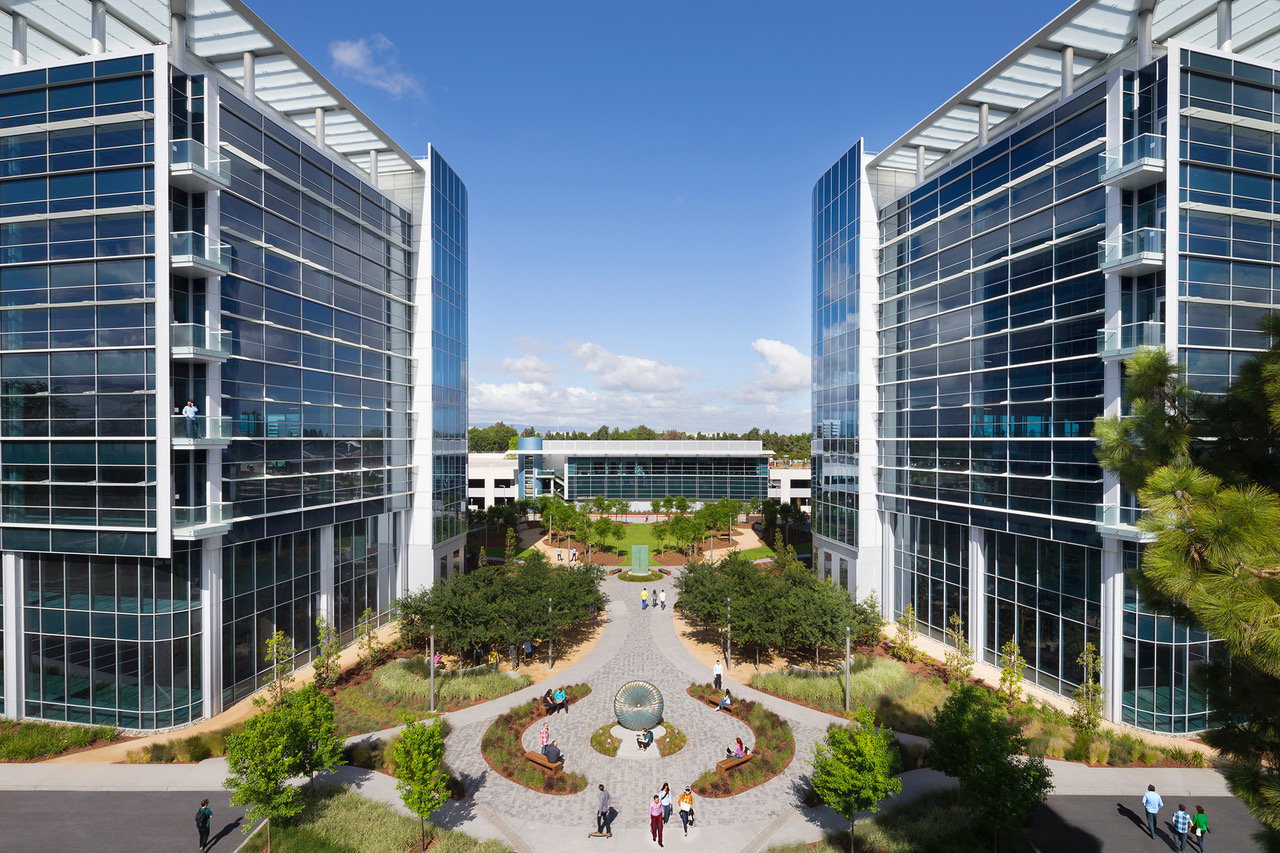
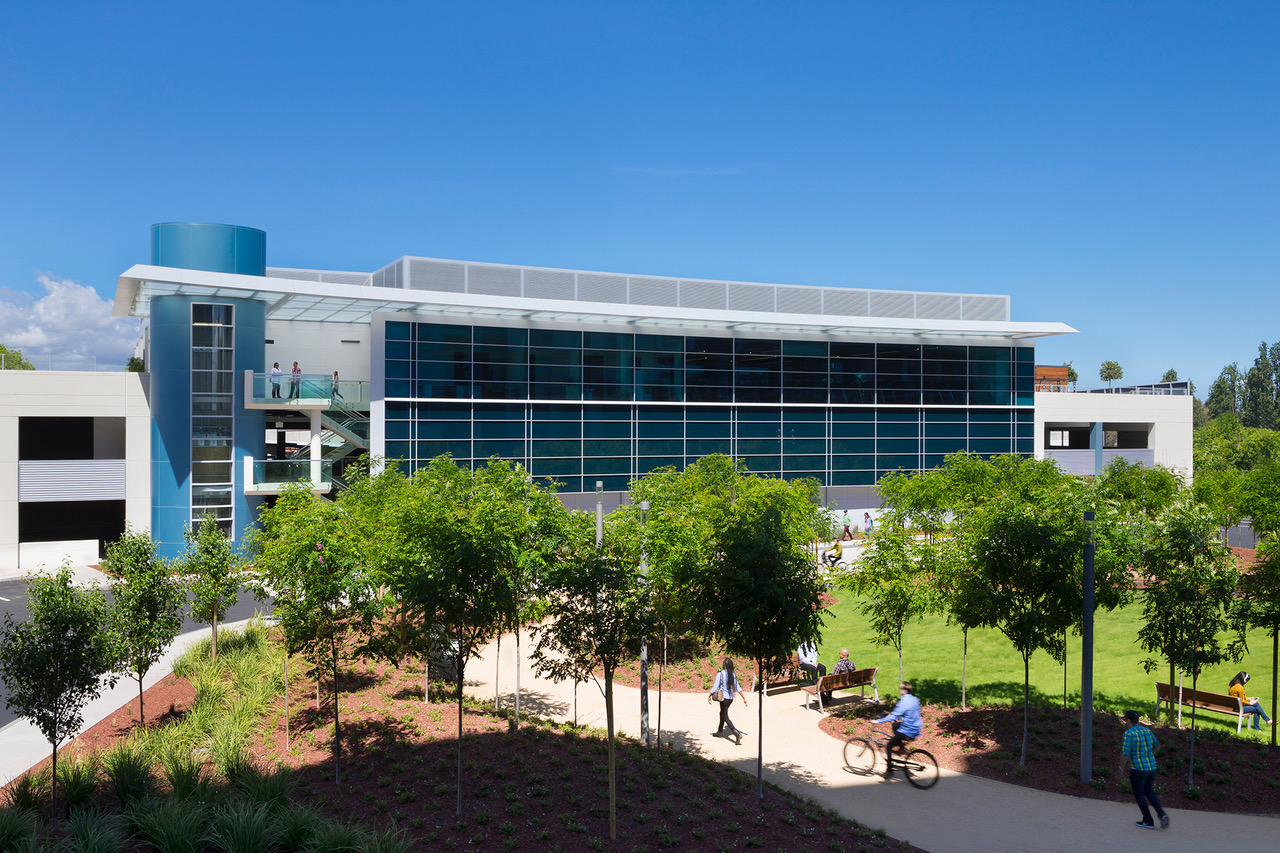
We are talking about creation of the new construction sector based on effective use of materials and consumption of energy resources. Development of this sector means transition from construction of buildings as resource gobblers towards creation of buildings as smart consumers, and in some cases (incl. green constructions, energy-efficient landscaping low-energy houses, freshomes and passive houses) as their generators and storages (Ryker, 2005).
In a word, the time has come for most every building to become an ecologically pure environment for living according to Kisho Kurokawa (Ayers, 2012; Williams, 2012a). The question is of the adequate environmental safety. The new ‘green’ buildings will become more comfortable and safe for people, like bird’s nests keeping the birds safe and comfortable, or like Kazuhiro Yajima’s tea house, the mini-urbanization of House in Yamasaki (designed by Tato Architects in Hyogo Prefecture, Japan) representing harmonious entwinement of both traditional and modern motives with tender approach to the surrounding natural landscape (Williams, 2012b).
Figure 3.1
Kazuhiro Yajima’s umbrella tea house (total floor area: 5.9sqm, bamboo, nonwoven fabric, tatami)
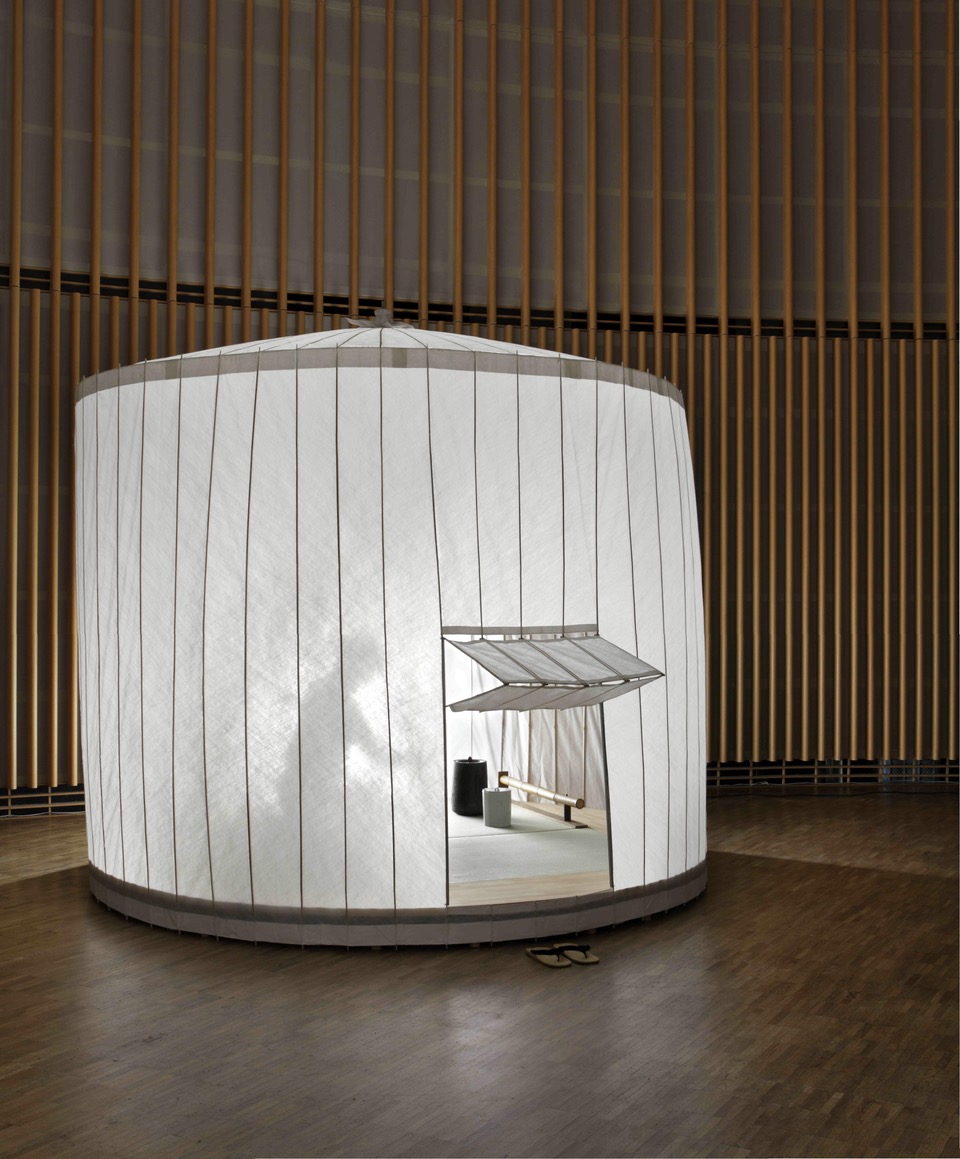
-----
Figure 3.2
Mini-urbanization of House in Yamasaki designed by Tato Architects in Hyogo Prefecture, Japan
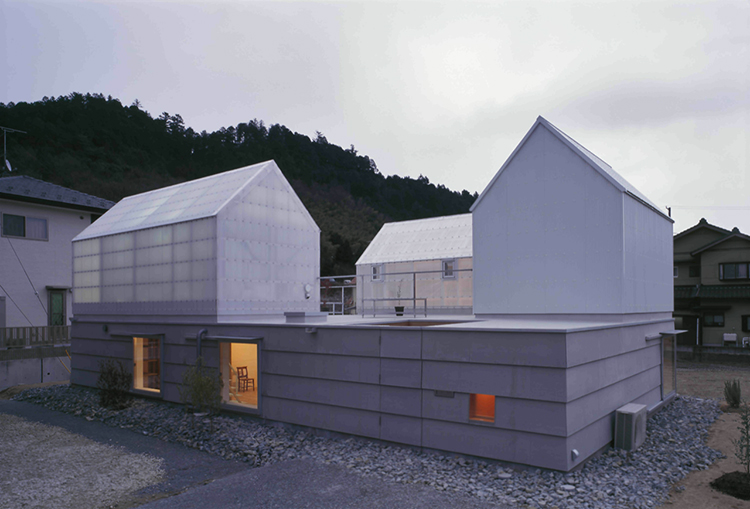
Optimal living environment, individual requirements to the premises depending on the purpose of the latter, minimal ecosystems dysfunction during construction – all that shall eventually lead to reduction of construction and maintenance costs, ensure coevolution of a man and environment and provide the environmental safety for the generations to come according to the ‘Concept of sustainable development’ (Glazychev, 2013).
However the unfolding intellectualization of buildings shall not be viewed as just the economic appeal. Some time ago a well-known American economist Mr. M. Porter (1998) pointed out, that the major and worst ever mistake often made by the innovators and strategists in the economics is their struggle with competitors in the same niche. Copying your rival's actions is the worst ever choice you can make (the company's primary target shall lie in high investment capital profitability ratio, whereas simple growth of the company, i.e. market share gain, increase in revenue, gain in sales, etc. shall be its secondary aim, that shall be addressed after the first and major target is reached).
Hence environmentalists raise the question of development of individual requirements for design of buildings and structures, construction materials and the construction process itself, study of parameters aimed at achieving minimum possible combined costs and maximum possible environment preservation. Most essentially the architecture and construction shall provide a wide range of possibilities for innovation. Ineffective costly technologies associated with destruction of the environment, annihilation of natural biosphere equilibrium, threat to environmental safety are incompatible with the new standards of design and construction (Szokolay and Brisbin, 2004; Proctor, 2015; Jones, 2008).
There is a belief that correctly designed and equipped building can maintain its investment value for a much longer period compared to that of a building failing to meet the requirements of tomorrow. However the authors of the digest take a further step: End consumer shall be furnished with maximum comfort and environmental safety while the costs are kept to a minimum. Here the idea of development of scientifically reliable information on construction materials, temperature, humidity and illumination levels, composition of supplied natural gas, speed of ventilation airflows, noise and electromagnetic emission, current state of the environment, etc. (Anisimova, 2009; Sayigh, 2014) All these factors are viewed in relation to the certain type of buildings and structures (even including construction of nuclear facilities, newest types of road intersections, etc.).
It was as early as the late 18th century that Thomas Malthus (2013) wrote his book making an attempt to provide quality substantiation of population size development. He provided mathematical definition of the following principle: The geometrically growing population shall overtake the linear growth of production of consumer resources.
Over a hundred years long Malthus’s calculations were taken skeptically, however in the second half of the 20th century his assumptions did draw public scrutiny. World population growth has acquired the character of a demographic explosion. And that now represents a key problem to global ecology. Having assumed material well-being as their major goal in life and not having produced the mechanisms for non-violent limitation to the number of population, the people rapidly destroy the natural environment which they are unable to live without. As it turns out, growth of population and industrial progress have their objective range of growth. The only option for adequate development may be population stabilization and industrial output.
One thing is clear: Economic growth as it is cannot solve even the smallest amount of problems our society is facing, for depletion of resources component of the economy may result from keeping to the existing industrial conditions.
Secondly, the currently prevailing technologies and social relations do not contribute to providing environmental safety and can lead to global biosphere disaster.
Thirdly, serious threat is incurred by social stratification. Rising inequality of incomes results in poverty. The Global Wealth Report drawn by Credit Suisse bank in 2012 evaluates the Gini coefficient (showing the degree of inequality in distribution of incomes) for Russia at 87 %, which is the maximum value among all the largest countries of the world (Global Wealth Report, 2015)
Thus another direction of research done by the scientists is addressed to finding alternative models for stable economic development based on balanced scientific and technical progress taking into account the predicted estimates of industrial growth limit (Heinberg, 2011). As a result, saving resources, solicitous attitude to the Earth and to the Heaven, saving of Labor, alteration of contents, conditions and organization of labor shall become an essential feature revealing humanitarian essence of scientific and technical progress, enhancing the understanding of the person's place and role in the production process, will provide higher environmental safety for itself and its descendants, stronger relation with the nature, from which the mankind moved off in the modern state of its existence.
Any piece of art is directed into future. One can find many examples in the history of arts, when the artists warn the mankind about the approaching threats: wars, epidemics, revolutions, etc. A capability of providence is appropriate of the great artists, probably this very feature makes the main force of the art.
At the beginning of XVI century Albrecht Durer, German painter and black-and-white artist of the Renaissance era, created a series of prints ‘Apocalypse’. The artist had expressed an anxious expectation of global humanitarian and environmental catastrophes, which actually shaken Europe some time later. Even though a notion of environmental safety proper would appear much later being a consequence of the technical progress and hard human impact on the nature, a print ‘Four Horsemen’ can be already attributed to a series of predictions on the relevance of this notion. The Horsemen implying Death, Court, War and Plague violently sweep over the Earth with no mercy either to the kings or to the commoners. The curling clouds and horizontal strokes of the background increase the speed of this mad gallop. But an arrow of the archer strikes against the right-hand edge of the print as if stopping this motion, as though abandoning any hope for enlightenment, for appearance of ‘noosphere’. According to the plot of biblical Apocalypse the Horsemen appear on the Earth one by one, but the artist has intentionally placed them nearby: war, plague, death and court come together. This is clear: absence of environmental safety in all spheres of human activity leads to a disaster. It is assumed that the answer to an enigma of suchlike arrangement of the figures lies in Durer’s intention to warn the contemporaries and descendants about that after smashing the wall erected by the artist in the form of the print edge the horrible Horsemen will unavoidably burst into the real world for committing punishment of the people breaking away from the nature and killing it. The eau-fortes by Francisco Goya (‘Mournful Anticipation of the Future’, etc.), pictures ‘Guernica’ by Pablo Picasso, ‘Bolshevik’ by Boris Kustodiev, ‘New Planet’ by Konstantin Yuon and many others are the examples of predictions of humanitarian disturbances and environmental tragedies through art.
Figure 4.1
The ‘Four Horsemen of the Apocalypse’ (1498) (’Apocalypsis’ is a famous series of
fifteen woodcuts by Albrecht Dürer [1471–1528] of scenes from the Book of Revelation)
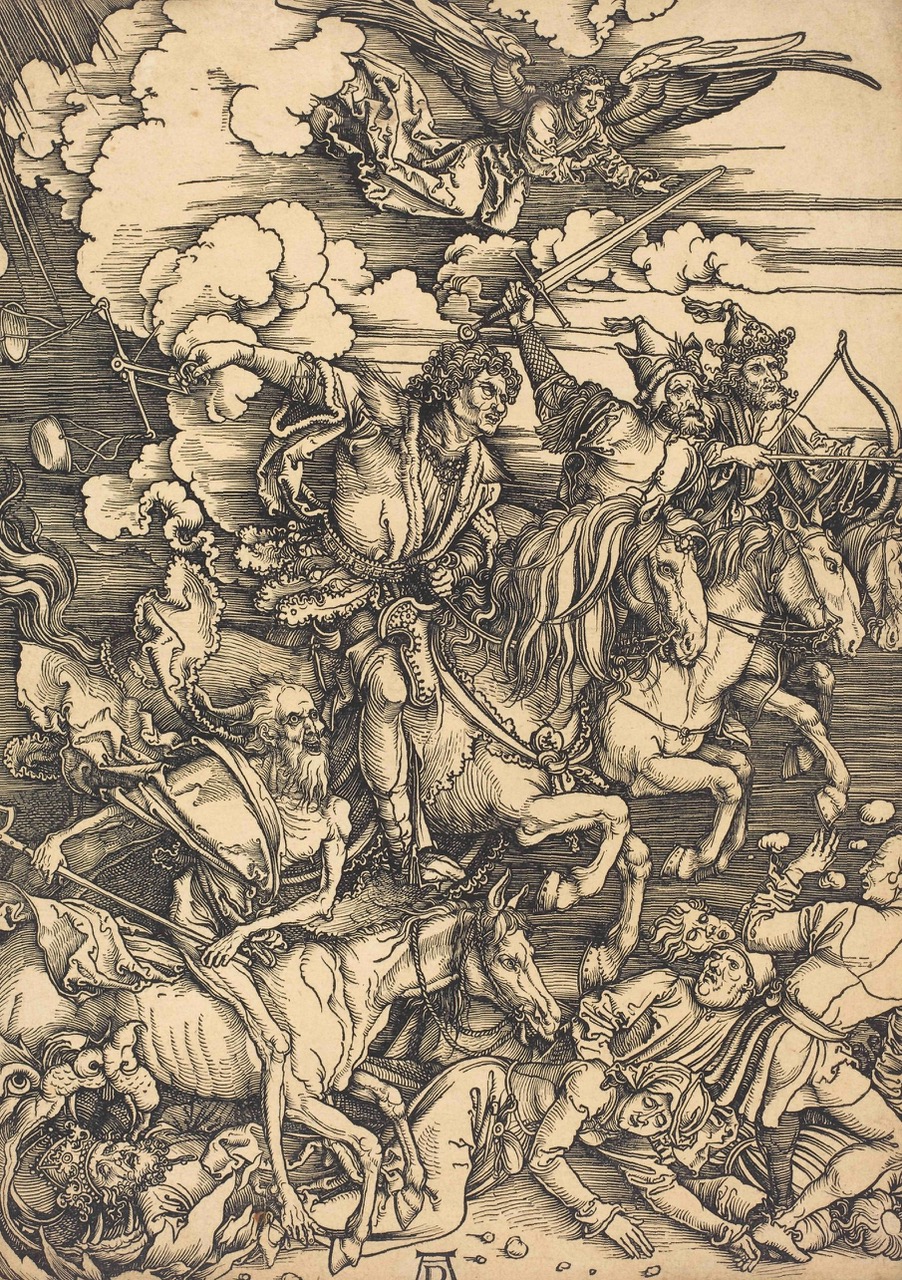
-----
Figure 4.2
The ‘Bolshevik’ (1920), painting by Boris Kustodiev (1878–1927)
(man in center: Vladimir Lenin, the political theorist who led the Bolsheviks)
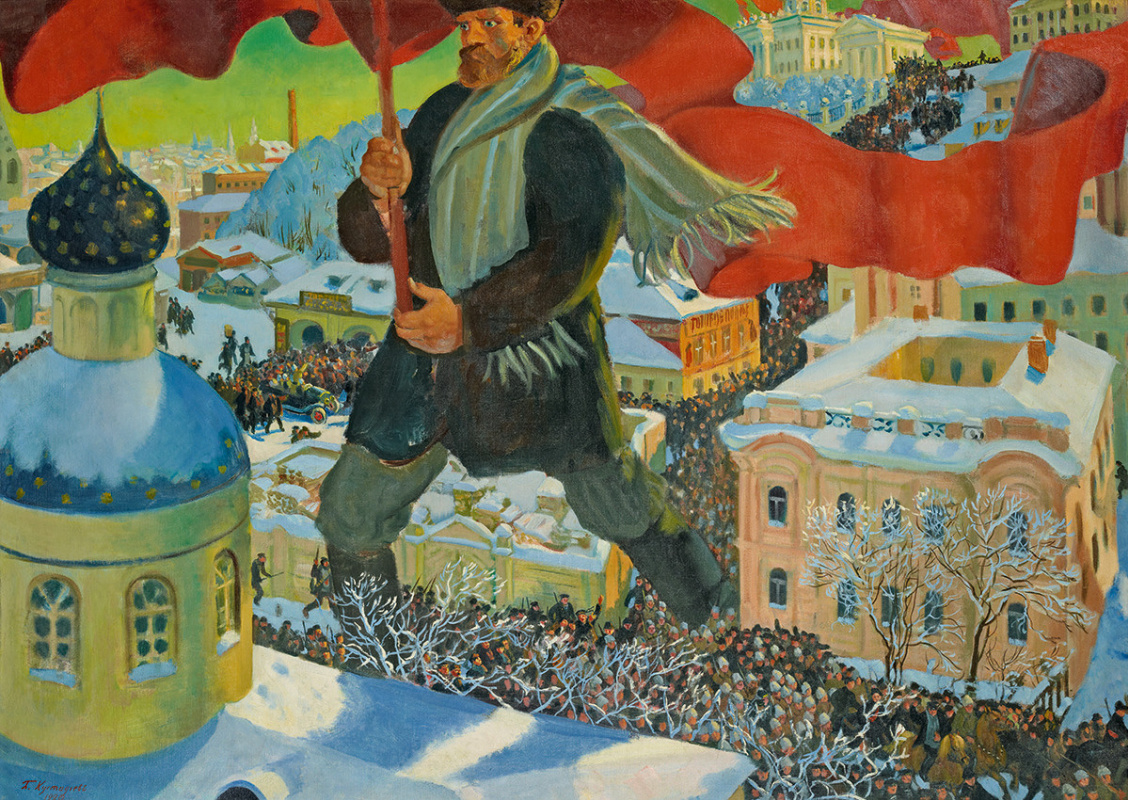
Kazimir Malevich presented his picture ‘Black Square’ in Petrograd in 1915. The epoch itself, large-scale technical and social transformations (that have been considered impossible earlier due to irrationality thereof) have imperatively dictated appearance of a new attitude to beauty, to environment, and to safety.
In one of the ‘Vitebsk Letters’ Kazimir Malevich wrote: ‘I see in this [black box – E.S.] is that once people saw in the person of God’ (Malevich, 2000). The author has characterized the picture as a ‘bare icon of my time without any frame’ presenting those things for human contemplation, which it was unable to see to its physical imperfection. The ideal tableau, the simplest geometrical figure (square painted with homogeneous paint on white flat background, in case of its demonstration the center is perpendicular to the viewer’s vision point) – ‘encompassed all the scenic views, existing before that’, ‘as an absolute form’ concentrated in itself all the hidden things and capabilities, including the biggest disasters and adversities full of surprising depth and relevance. The ‘Black Square’ has become in this context one of the first demonstrations of the dangers related to uncontrolled and economically unprofitable community progress, it has become a symbol of necessity of environmental and technosphere safety. After all, a man will not exist without protection of the environment, it is an axiomatic statement, which does not require any proofs, a knowledge, with which we can't but agree.
Figure 5
The ‘Black Square’, Kazimir Malevich (1878–1935)
(The first ‘Black Square’ was painted in 1915)

Alberti, M., J.M. Marzluff, E. Shulenberger, et al. 2008. Integrating humans into ecology: opportunities and challenges for studying urban ecosystems. In: J.M. Marzluff (ed.), Urban Ecology: An International Perspective on the Interaction Between Humans and Nature. New York: Springer, pp. 143–159.
Alekseev, M. and E. Smirnova. 2016. Waste water of north-west Russia as a threat to the Baltic. Journal of Environmental Engineering and Science, 11(3), 67–78.
Anisimova, I.I. 2009. Unique Buildings (from Frank Lloyd Wright to Frank Owen Gehry). Moscow: Architecture.
Applegate, J.S. 2004. Environmental Risk. Aldershot, Hants, England; Burlington, VT: Ashgate/Dartmouth.
Ayers, A., 2012. Fun Palais. The Architectural Review, 6(228), 44–51.
Brenson, M., 1990. Malevich's Search for a New Reality. The New York Times, September 17, 1990. Retrieved from: http://www.nytimes.com/1990/09/17/arts/review-art-malevich-s-search-for-a-new-reality.html?pagewanted=all/.
Glazychev, V., 2013. Design as It Is. Moscow, Europe Publishing.
Global Wealth Report, 2015. Russia – A lost decade. Zurich: Research Institute Credit Suisse AG. Retrieved from: https://publications.credit-suisse.com/tasks/render/file/?fileID=F2425415-DCA7-80B8-EAD989AF9341D47E/.
Heinberg, R. 2011. The End of Growth: Adapting to Our New Economic Reality. Gabriola Island, BC: New Society Publishers.
Jakovlev, V.V. 2007. Jekologicheskaja Bezopasnost', Ocenka Riska [Environmental Safety, Risk Assessment]. St. Petersburg: State Polytechnic University, p. 10.
Jones, L. 2008. Environmentally Responsible Design: Green and Sustainable Design for Interior Designers. Hoboken, NJ: Wiley.
Kasperson, J.X. and R. Kasperson. 2001. Global Environmental Risk. Tokyo: United Nations University Press.
Malevich, K. 2000. Suprematizm. Mir Kak Bespredmetnost', ili Vechnyj Pokoj. S Prilozheniem Pisem K. Malevicha k M.O. Gershenzonu. 1918–1924 [Suprematism. World as aimlessness, or eternal peace. With enclosure of letters from K. Malevich to М.О. Gershenzon. 1918–1924]. In: A.S. Shatskih (ed.), Complete Works of Malevich. Т. 3. Moscow: Gileja.
Malthus, T.R. 2013. An Essay on the Principle of Population: As It Affects the Future Improvement of Society. Lexington, KY: Malthus Press.
Marinetti, F.T., 1973. The founding and manifesto of futurism. In: U. Apollonio (ed.), R. Brain, R.W. Flint, J.C. Higgitt and C. Tisdall. (transl.), Documents of 20th Century Art: Futurist Manifestos. New York: Viking Press, pp. 19–24.
Palumbi, S.R. 2008. Humans as the World’s Greatest Evolutionary Force. In: J.M. Marzluff (ed.), Urban Ecology: An International Perspective on the Interaction Between Humans and Nature. New York: Springer, pp. 15-24.
Porter, M.E. 1998. Competitive Strategy: Techniques for Analyzing Industries and Competitors. New York: Free Press.
Pritchard, P. 2014. Environmental Risk Management. London: Routledge.
Proctor, R. 2015. Sustainable Design Book. London: Laurence King Publishing Ltd.
Ryker, L., 2005. Off the Grid: Modern Homes + Alternative Energy. Salt Lake City: Gibbs Smith.
Sayigh, A. 2014. Sustainability, Energy and Architecture: Case Studies in Realizing Green Buildings. Amsterdam: Elsevier.
Szokolay, S.V., Brisbin, C. 2004. Introduction to Architectural Science: The Basis of Sustainable Design. Amsterdam; Boston: Elsevier, Architectural Press.
Tyler Miller, G. and S. Spoolman. 2015. Living in the Environment. Stamford: CT Cengage Learning, pp. 23–24.
Vernadsky, V.I. 2012. Biosphere and Noosphere. Moscow: Airis-Press.
Wackernagel, M. and W.E. Rees. 2007. Our Ecological Footprint: Reducing Human Impact on the Earth. Gabriola Island, BC: New Society Publ.
Williams, A., 2012a. Toda House, Hiroshima, Japan. The Architectural Review, 7(229), 62–63.
Williams, A., 2012b. Umbrella Tea House, Japan and Kazuhiro Yajima. The Architectural Review, 10(232), 46–48.
Williams, D.E. 2007. Sustainable Design: Ecology, Architecture and Planning. New York: John Wiley and Sons.
Wittig K., Вreuste J., Finke L., et al. 2008. What Should an Ideal City Look Like from an Ecological View? – Ecological Demands on the Future City. Integrating humans into ecology: opportunities and challenges for studying urban ecosystems. In: J.M. Marzluff (ed.), Urban Ecology: An International Perspective on the Interaction Between Humans and Nature. New York: Springer.
1. PhD in Chemistry, Associate Professor. Saint Petersburg State University of Architecture and Civil Engineering. Vtoraja Krasnoarmejskaja ul. 4, St. Petersburg, 190005, Russia. E-mail: esmirnovae@yandex.ru